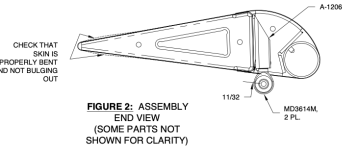gmcjetpilot
Well Known Member
Helping a builder with Phase 1, slight left wing heavy. Looking and TE bend radius all looks good except two bays (about 6" each) on left Flaparon. If it were to decrease bend radius more it would make the left wing heavier. Right now we are doing nothing. Van says this is normal and on their S-LSA they typically have to do some tweak's. Plane is well built and fly's well, book specs. Eventually want to fine tune this (without over dooing it).
My question is how difficult is it to get at the mxing links? What do you suggest in how to adjust.
Looking at the TE alignment there looks to be some out of alignment or rig (slight). But it also seems to be opposite of what I'd expect for slight LEFT wing heavy. Again the condition is minor, but noticeable. I don't want to increase or make the issue worse.
Increasing the RIGHT Flaperon TE radius is not an option as that one has perfect bend radius and any more would be over done.
BTW I am a TE expert, in that I mean 25yrs ago with my RV-4 I over did the aileron TE bend and ended up reskinning one aileron. I know to be very careful, make tiny incremental changes between flight test.
May be leave it alone? The plane has two 180 lb pilots, full to half fuel. As I said it flys nice but not hands off. May be this is an RV-12iS thing and chasing this down to the Nth degree of roll perfection is not needed or possible?
My question is how difficult is it to get at the mxing links? What do you suggest in how to adjust.
Looking at the TE alignment there looks to be some out of alignment or rig (slight). But it also seems to be opposite of what I'd expect for slight LEFT wing heavy. Again the condition is minor, but noticeable. I don't want to increase or make the issue worse.
Increasing the RIGHT Flaperon TE radius is not an option as that one has perfect bend radius and any more would be over done.
BTW I am a TE expert, in that I mean 25yrs ago with my RV-4 I over did the aileron TE bend and ended up reskinning one aileron. I know to be very careful, make tiny incremental changes between flight test.
May be leave it alone? The plane has two 180 lb pilots, full to half fuel. As I said it flys nice but not hands off. May be this is an RV-12iS thing and chasing this down to the Nth degree of roll perfection is not needed or possible?





